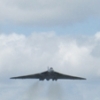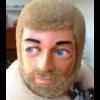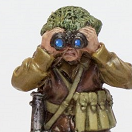Search the Community
Showing results for tags 'Red Arrows'.
-
Hi all, Just read on the BBC that the defence secretary has stated two key things: 1. The red arrows will stay in operation 2. The team will get new aircraft in the "next few years" So, the obvious question is: what aircraft will they likely have? (I would like to see them reform with red f35's or typhoons personally but that doesn't seem likely...) Kind regards, Edit: link, http://www.bbc.co.uk/news/uk-england-37833311
-
Another one from my 1/32 collection. Built out of the box with the only aftermarket detail being the ejection seats from exta boost. From memory the kit went together ok but the nose of the aircraft needed a fair bit of filler, however this may have just been builder error. Painted in tamiya acrylics via an airbrush. Let me know your thoughts. Thanks Rob
-
May I present a 1:48 scale Ba.e Systems Hawk T1a (or is it a T2a now?) in what I believe is the Red Arrows 2023 display livery based on various photos sourced via Google. After a good start I lost my modelling mojo in the middle of this build and had a complete mare with the airbrush that resulted in a blotchy finish to start with and a less than perfect final finish. I also tore several of Hobby Boss’s very thin decals during application. However, after giving myself a talking to and a stiff drink I was able to pull it back from being a complete disaster and it looks sort of OK from most angles, provided you don’t look too closely at the starboard cockpit side or the wing undersides.😉 This has been a very real exercise in the Japanese aesthetic of Wabi-Sabi, which acknowledges three simple realities: nothing lasts nothing is ever finished, and nothing is ever perfect. So please accept the flawed beauty of my offering. I think I pulled off a blinder with the stand however. I can pose the model in any rolling attitude I want as it climbs out on its column of acrylic jet exhaust, embedded but freely rotatable in a polished oak base. I also bought a small Red Arrows squadron pin badge and have mounted this on the base. I’ve posted this ahead of applying a final sealing gloss clear coat, because I’d like some advice on whether the Arrow’s Hawks have any of the generic placards to be found on other RAF Hawks, such as the trestle points and various warning messages. Versions of these are supplied on the Hobby Boss decal sheet, but I can’t see them in any of the on-line photos of XX219. If anyone out there can point me at references for those that are to be found on XX219, I can maybe then add them before sealing the whole thing up. If you’re interested in the various mods I made and the various pitfalls I avoided with Hobby Boss’s offering, please read on after the pictures. One last thought. Since the Arrows have been flying Hawks since 1980, should we refer to them as a vintage aircraft display team?😆😆 These cheatlines were tricky to get right. I had to remove my first attempts because they were too low down on the fuselage to merge well with the pitot, but fortunately HB supply two sets of lines for the two liveries on the decal sheet, so I got them right second time. My advice is to start at the tailfin with the stripes and finish at the pointy end. Revell 1/72 Spitfire Vb "Waldermar Attertag" in the background here. My only other "airworthy" model with gear up.😉 Moulded in det cord is just about passable I bought the kit via Amazon on a whim last summer, basically because at £15 it looked like a bargain. I gave it a quick look over when I bought it and thought it looked at first sight to be quite a good buy. I didn’t get around to looking at it more closely until I decided to start building it at the start of April 24 and that’s when some of its limitations became apparent. In short: · Too many wing fences · Incorrect Type A pre 1945 Roundels on the decal sheet (also dodgy colours?). My admittedly limited experience with Chinese manufacturer’s kits is that they probably need to do more homework in this respect · Incorrect ejector seat head boxes for the MB mk 10s fitted to Red Arrows Hawks Weirdly, the box art is more accurate than the kit on all three points. So what started out as a planned weekend build, turned into a more extensive project. I also made life hard for myself by deciding to build a dynamic in flight configuration and this meant sourcing a suitable pilot figure in addition to making a custom stand. T1a wings only have one fence each, but there are three on each of this kit’s wing parts. Hobby Boss have released several iterations of Hawk variants and I guess you can forgive them for providing one wing moulding based on the 200 variant which has three fences on each wing, because it’s easy enough to slice the extra ones off. However, they make no attempt at informing the modeller that surgery is required for the Red Arrows variant. There's also no attempt to recreate the "Toblerone" stall strips on the wing leading edges. I made mine out of thin plastic card strip. Wing parts with fences & extra fences Removed The incorrect roundels were a simple fix. I ordered the Xtradecal X48037 RAF post WW11 decal sheets from Hannants and added a Montex MXSM48419 canopy mask set to my order whilst I was at it. Other than these glaring errors, the configuration looks to be generally OK, but I haven’t checked the dimensions, although the overall shape has an air of truthiness about it. However, the surface detail is quite subtle and perhaps a little too subtle where some of the control surface hinge lines are concerned. The dry fit of parts was however excellent and they provided some PE parts for the cockpit. I bought some 1/48 scale resin modern jet pilot figures off ebay and made the stand base from a piece of oak left over from my custom built HMS Victory case. I had to anatomise the selected figure completely to get him/her to fit the seat whilst HOTAS. I thought I would pose the aircraft in a dynamic climbing flight pose by supporting it through the jet pipe using a 4mm diameter clear acrylic rod sourced via Amazon. When the rods arrived I discovered they had a set of nine thin white go faster stripes running down their length like a stick of Blackpool rock. 😆 I was initially disappointed, but when viewed from a distance, I decided it did sort of look like a vapour trail. I plugged the empty rear seat shoulder strap buckles into their holding slots on the headbox as per photos seen of the seat on the ground. Not sure they would be there in flight, but because I couldn't find any other references I went with what I could see. I decided to modify the kit ejection seats rather than replace them. I cut off the sides of the head boxes with a razor saw and built up the correct shape of the Martin Baker Mk 10 seats using plastic card. I painted the pilot up in the Arrows signature red flight suit, dark green G-trousers, khaki life vest, black leather flying gloves and a white helmet with the red arrow logo on the back. The rear seat fouled the canopy initially, but I removed the base part from it and it then fitted in OK. All the cockpit and pilot details are however somewhat lost under the closed canopy with its moulded in det cords. My search for the best colour match for an authentic Red Arrows red led me to the Humbrol 238 Red Arrows Red acrylic paint. However, a test shot of this on my 1/72 Eurofighter painting mule left me somewhat underwhelmed. Despite claiming to be a gloss finish, I was unable to get a “wet” look coat and my airbrush clogged up fairly quickly. I was in my local hobby store buying a few supplies and I spotted a pot of Revell Color Coat Feuerotte, which without a colour chip to reference sounded like if it might be a good match. So I took a punt and bought it. A test shot on the mule showed it was virtually identical to the Humbrol paint in colour and hue, but unlike the Humbrol paint I was able to get a fairly good gloss finish with a final wet coat. I also used some of the second livery decals provided by Hobby Boss to check whether the very thin white decals were dense enough to cover over the red without colour bleed through. The test result was marginal, so I also opted to apply a coat of clear over the gloss red before decaling to help prevent this. It seems to have worked. Apart from the roundels, the main Hobby Boss decals are generally OK, but I had to cut out the red sections from the tail fin markings because it’s unlikely they would’ve been a good match to the chosen paint finish. Also, the underside white arrow markings stop short before forming the arrow head point ahead of the diesel tank, so I had to extend the supplied decals by adding some custom cut sections. Hobby Boss really didn’t think these aspects through, did they? They also appear to have had a double think when it comes to the canopy explosive det cords. They’ve moulded these into the canopy, but also provide decals for them. However, the decals are much smaller in size than the moulded in versions and are therefore useless. In my opinion it would have been better to have provided decals only, because the moulded in cords distort the otherwise crystal clear canopy somewhat. Then there are the ejection seat warning triangles and the other canopy frame markings on the HB decal sheet, which don’t match up with any of the photos I could find. I ended up buying a further Xtradecal X48095 decal sheet for two other RAF display Hawks to get versions that look more like the real thing. Even so, the Xtradecal warning triangles are a little too finely executed and are therefore appear less prominent than those on the real thing. My £15 bargain has ended up costing substantially more to make a half decent job. So my advice would be to perhaps buy an Italeri or Airfix kit instead. What's been others experience with the various kits?
-
Hello Everyone, While parts for my Type 45 destroyer build we're drying, I decided to make a start on another kit from my stash. At my wife's insistence, I started work on an Airfix 1:72 scale Red Arrows Gnat which has been sitting in the stash for a while. I will post sprue photos later along with the 1st construction photos. I'm working on simple builds while my destroyer is drying etc. All the best, Rick
- 5 replies
-
- Airfix
- 1:72 scale
-
(and 1 more)
Tagged with:
-
Folland Gnat T.1 (A02105) 1:72 Airfix The Gnat was a developmental evolution of the earlier Midge that Folland had worked on without Government sponsorship as a small light-weight fighter of simple construction that would be easily made without massively specialised and expensive tooling. The Gnat kept to this ethos, and although it didn't find favour with the Ministry of Supply as a fighter, it did find a niche as a jet trainer. Elsewhere it was used as a fighter and trainer, but its most high-profile use that gave it a lasting place in the heart of many aviation enthusiasts was as the aircraft of choice for the Red Arrows until their replacement by the BAe Hawk T.1 in 1979. As a trainer with the RAF it served from 1965, allowing pilots to get up to speed with fast jets before being streamed into their eventual speciality. At the end of 1978 the drawdown of Gnat airframes reached critical mass, with the unwanted aircraft being sold on to other operators, private or otherwise. India built single seat F.1 Gnats under license as the HAL Ajeet, as well as the more familiar two-seat trainers, although they were quite different to those used by the RAF. There are still plenty of Gnats on display in museums where they don’t take up much room, and three are often seen in the skies at UK airshows, which is a lovely sight, especially as one flies in the Yellow Jacks colours, another as a Red Arrow, and the third in trainer red/white/grey. The Kit This is a reboxing of the 2012 tooling by the (then) recently reinvigorated Airfix under Hornby’s ownership, which replaced the original tooling that is probably older than most of us. It arrives in a small top-opening red-themed box with the lid taped down. Inside are two sprues of grey styrene, a separately bagged sprue of clear parts, decal sheet and instruction booklet that is printed in colour with the decal profiles on the rear pages. Detail is good, and it extends into the cockpit and gear bays, a huge improvement over the old tooling. Construction begins with the rear seat, which is the early Folland version with the tubular “shoulders”, which is fitted to the rear bulkhead and joined to the floor, along with two control columns and the front seat after attaching it to its bulkhead, adding the rear instrument panel to the back of it, applying the dial decal once everything is painted. The front panel is similarly appointed with a nice decal, and both are without a coloured background, so you can paint the panel without having to match colours. The fuselage halves have the intake lips added to the outside, and the trunking is installed from within after painting the interior silver. Those inserts have the rear cockpit sidewalls moulded into them to match the front sidewalls that are moulded into the fuselage halves. The main gear bays are installed from within, adding the gear legs if you are planning on posing your model gear down, using just the bays for the gear up option. Both legs have their captive bay doors fitted to the front of the legs, although these and probably the legs could be left off until after main painting is completed. The fuselage can be closed around the cockpit once the sidewalls are painted, and there is some space for nose weight even though the instructions don’t mention any. After dealing with the seams, there is a choice of two inserts that fill in the space between the main gear bays, one with the bay doors moulded-in for gear up, and another without for gear down, drilling out the flashed-over holes from within if you are using the Airfix stands that are available separately. For gear up, the nose gear has a bay door inserted, or the strut with twin wheels and bay door for gear down. The main gear wheels are fitted to the axles at a 5° angle to the vertical, as shown in the accompanying scrap diagrams, which also show the angles of the bay spats. The upper wings are full span and include a section of the top fuselage and spine, fitting the lower wing halves after drilling out the holes for the almost ubiquitous slipper tanks. The wings fit over the fuselage, the elevators slot into the sides of the tail, and an exhaust can is inserted into the rear of the fuselage, and although it’s shown painted in gunmetal, you might want to check your references. The two slipper tanks are made from two halves plus a rounded nose, and careful fitting should simplify clean-up of the seams later. They fix to the holes drilled in the underwings, then you can choose whether to use the two identical pilot figures before gluing the canopy over the cockpit. The final parts are a pair of blade antennae on the spine, and you should check your references for their angles from the front. If memory serves, at least one is not vertical. The comparatively enormous probe inserts into a slot below the clear nose light to finish the build. Markings There are two decal options on the sheet, one of which is firmly based in the real world, the other based on fever dreams from a Hollywood script-writer’s pen. From the box you can build one of the following: Folland Gnat T.1 No.4 Flying Training School, RAF Valley, Anglesey, Wales, 1970 Oscar EW-5894 Fallus Tactical Fighter Bomber, USS Essess, Mediterranean/Gulf, 1991 Decals are by Cartograf, which is a guarantee of good registration, sharpness and colour density, with a thin gloss carrier film cut close to the printed areas. Just in case you missed the reference, the second decal option is from the comedy movie Hot Shots that was released in 1991, and was so well-liked that it was followed by a sequel Hot Shots Part Deux in 1993. It has ‘The Navy’ writ large on the sides of the nose, and a ring of fake rocket apertures painted on the slipper tanks to give it a more aggressive look for the movie. Conclusion The Gnat is a small aircraft in the flesh, and is almost too wee in 1:72, but the model has plenty of detail moulded-in. The second decal option made me smile too. Highly recommended. Review sample courtesy of
-
I started the build from Red Arrows Airfix box and intended to do a black Hawk XX-193. During the initial work I realised that Airfix produces two different sprues and kits of BAe Hawk. From the Red Arrows box is only possible to build the Hawk of that acrobatic group. The kit hasn´t the gunsight and is generally simplified and cheaper. The canopy is one piece, there are a minor differences in panel lines, the wing is moulded together with aerodynamic fences. The fitting and building of this kit version is surprisingly slightly better than the other kit. Unfortunately I don´t understand why there is missing the rear part with tubes for making coloured vapour trails. Generally as I wrote in my building thread, I am quite disappointed with overall quality of all the Airfix kits. At the end I build both kits. The Red Arrow and the other in black. (Later I will also post it into the gallery). The choice of the camouflage of Red Arrows was not easy as one man could expect. The planes were time to time a slightly different in marking. Finally I was interesting in the Hawk XX179. I found that the XX179 flew first female pilot Flt. Lt. Kirsty Moore at the Cotswold Airshow 2011 under formation no.5. Unfortunately I was not able to collect exact time sequence of her career. In some time period she was named Kirsty Steward and then also Kirsty Murphy as she got married with former Red Arrows squadron leader Ben Murphy. Unfortunately the career of Kirsty in Red Arrows team was ended due to certain psychological aspects as there were two serious accidents with pilots dead. In the first one in august 2011 near Bournemouth air base the Hawk XX-179 was completely destroyed.
- 11 replies
-
- 47
-

-
- BAe Hawk T1
- Red Arrows
-
(and 1 more)
Tagged with:
-
And now for something completely different... For my 70th Birthday my sister gave me an Airfix Starter Set Red Arrows Hawk, one of 7 presents each to highlight a stage in my life! Yesterday I made the kit.... Here it is, ready for inspection.... Building it took all of 3 hours, painting and applying transfers another 2. These kits are designed to be simple to build, few parts but beautifully moulded and the detail is good. The instructions are brilliantly clear and simple, perfect for a beginner. The kits are supplied with paint... Airfix acrylic and the red and white had started to set. I used Tamiya red and white. The hardest part was applying the transfers, very thin and lining up the white stripe was difficult as it is in 3 parts, plus the fin flash in 2 more. With Hindsight I'd have started at the fin and worked forward. Anyway, a trip back to 1962 when kits were simple and built as soon as we got them home. I've not had so much fun building a kit in years, big "Thanks" to Sister Sue!
- 5 replies
-
- 12
-

-
- starter set
- BAe Hawk T1
-
(and 1 more)
Tagged with:
-
Morning all! Well, my second topic for this fine forum....A friend of mine has commissioned me to build him a BAe Hawk T.1 as part of his on going projects for his artist page. https://www.facebook.com/mrlongtheartist/ I've previously built a 1:32 scale Mk.IIb Spit for him, which features in his piece "with the sun at my back" as reference points for him. In his next project, the BAe Hawk is the subject of choice, and here is the build log for it.... DSC_1179 DSC_1180 A decent full colour instruction manual DSC_1181 DSC_1183 Decal sheet is nice and thick, especially the white markings DSC_1182 Red Sprue's to hopefully help with the final paint of Tamiya TS-49, there's a bit of flash from themould, but generally its a good level of details for a 1:72 scale kit. DSC_1184 My only concern is the det cords for the canopy...my thinking is to apply a gentle wash of white so that the paint recess into the det-cord sections and then wipe away the excess paint whilst it is still wet. The cockpit goes together fairly quickly, and I've decided to try and paint the detail into the dials DSC_1186 Seats are up next, lots of detail on them as well. DSC_1185 thoughts / comments are all welcomed
- 60 replies
-
- 1
-

-
- red arrows
- Bae Hawk T.1
-
(and 1 more)
Tagged with:
-
Folland Gnat T.1 (A05123A) 1:48 Airfix The Gnat was a developmental evolution of the earlier Midge that Folland had worked on without Government sponsorship as a small light-weight fighter of simple construction that would be easily made without massively specialised tooling. The Gnat kept to this ethos, and although it didn't find favour with the Ministry of Supply as a fighter, it did find a niche as a jet trainer. Elsewhere it was used as a fighter and trainer, but its most high-profile use that gave it a lasting place in the heart of many aviation enthusiasts was as the aircraft of choice for the Red Arrows until their replacement with Hawk T.1s in 1979. As a trainer with the RAF it served from 1965, allowing pilots to get up to speed with fast jets before being streamed into their eventual speciality. At the end of 1978 the drawdown of Gnat airframes reached critical mass, with the unwanted aircraft being sold on to other operators, private or otherwise. India built single seat F.1 Gnats under license as the HAL Ajeet, as well as the more familiar two-seat trainers, although they were quite different to those used by the RAF. There are still plenty of Gnats on display, and three are often seen in the skies at UK airshows, which is a lovely sight, especially as one flies in the Yellow Jacks, another as a Red Arrow, and the third in trainer red/white/grey. The Kit 1:48 modellers had been waiting for years for a mainstream model of the Gnat, and with the exception of the beloved Aeroclub multimedia kit that I've had the pleasure of building, we were a bit left behind. When Airfix announced the 1:48 kit was announced everyone was pretty happy, with a few more boxings being released over time. Inside the small top-opening red box are three grey sprues, a clear sprue, a set of crisp decals, and one of Airfix's new style instruction booklets, which has spot colour and greyscale throughout. It's a lovely looking aircraft, and Airfix have done some very nice work in replicating its lines, with modern moulding techniques, fine panel lines, and detail that is thoroughly modern. Construction begins with the cockpit, which has a wheel bay hump added through a small hole in the rear floor, complete with some interior ribbing. The cockpit floor includes the side consoles with throttle quadrants and other instrument detail moulded in, plus some raised floor panels. The rudders are separate parts, as are the front and rear bulkheads, after which the instrument panels can be added to their slots in the floor along with the control columns front & rear. The detail of the instrument panels are depicted as 3D raised line drawings, and have no bezel or panel details that would be seen on the real thing, so are a little archaic compared to the rest of the detail. There are decals to fill the instrument faces, but as these areas are on full display under a large clear canopy, they could have been better. Speaking of the canopy, you get a two-part open, and single closed canopy to use, and the clarity is superb, with minimal distortion. I will be using the Eduard Zoom! to pretty up my instrument panels, as I like the extra realism without too much effort on my part. The ejection seats are multi-part, made from eight parts each, with a duplicate seat cushion with no seatbelts moulded in for use when you install the supplied three-part pilot. These are Folland's own lightweight 4GT/1 ejection seats, which have a prominent frame that extends up behind the head-box. The pilot's seat is added to a bulkhead before being installed in the cockpit, while the instructor's seat slots straight onto the rails moulded into the rear bulkhead. The fuselage's clean lines are spoiled on the sprues by the lack of intake trunking from its lip to the trailing edge of the wing. This is a wise move however, leading to easier joints to clean up, and easy accommodation of the full-depth intake trunking that's included with the kit. These curve around to pass the main gear bays, which also have some nice detail moulded in that is probably sufficient for most modellers, as it seen through only a small opening after completion. The cockpit is installed in the starboard fuselage half, as is the two-piece exhaust, which has detail moulded in, and an engine rear to cap the inner end. The front of the engine is slotted into the intake trunking end, a small nose electronics bay is added, and the fuselage can be closed up. The instructor's coaming can be added at this stage to cover the void between their compartments, to which the clear blast screen is added toward the end of the build. Later in the build the upper portion of the nose is added, and if you elect to leave this bay open, a small equipment cluster is added to the inside of the panel, the nose light is attached to the front, and a tiny blade antenna is added to a recess on the exterior. Sealing the bay omits the extra part, and requires you to remove the hinges from the panel that hold it in the correct position when posed open. The wings are full-span on the upper part, and have separate flaps and ailerons, with two-part lower wings. If you are installing the slipper tanks, you'll need to drill the flashed over holes in the lower wing, and once joined the wing is laid on the top of the fuselage, completing the spine that merges into the root of the vertical fin of the tail. If you look closely at the spine you will see a fractional mis-match between the panel lines running from each wing, but as it is so small (infinitesimal, actually), it will probably disappear under paint, or you could knock it back with a scriber. With careful fitting, a clean seam should be relatively easy to achieve, and the flying surfaces can be added now, or left off until later if you are offsetting them. Each surface is thin, so made from one part each, so just clean the mould lines, and you're done. The starboard side of the fin is a separate part, and attaching it captures the rudder between the hinge points, so it can be left loose or posed to one side or the other. The elevators fix using the usual tab & slot method, and should be at 90o to the fin. Their flying surfaces are moulded in, so some cutting will be needed if you want to move them. The commonly used slipper tanks that are suspended beneath the wings are made of three parts, with an insert that covers the cylindrical bottom section where the access panels are, and the nose cone slotting onto the end. Some slide-moulding has been done here, and fettling with plenty of test-fitting will be the order of the day to improve the fit and avoid using filler. The landing gear can be posed down or retracted for flight, with separate parts for each eventuality to make the modeller's life easier. The in-flight nose gear cover has a fin on the inside surface to prevent it from dropping back into the bay, which is very sensible. If you are using the landing gear, the legs are all single parts, and just need some lead wire to depict the hosing, although little will be seen of it once complete. The wheels are nicely done, with the two main wheels having separate outer hubs and a small hint of sag to the tyres under the weight of the airframe, but nothing excessive. The twin nose-wheels are one part each, and echo the slight sag of the mains. All the bay doors are provided with large attachment points, which should give a strong joint, and the main bay doors have rib detail too. A scrap diagram shows the correct angles from the rear, and another shows the location of the main bay door "spat". Clear parts are provided for the wingtip lights, the prominent nose-mounted landing-light, and of course the canopy, which as mentioned earlier is supplied as a single closed part, and a two-part open option, which is held open with a pair of hinge tabs at the rear, where it meets the fuselage spine. The large pitot probe and a few small blade aerials are the final tasks with the build, and these are shown from the front to aid correct positioning. Markings Three sets of markings are supplied with the kit, and from the box you can build one of the following: Central Flying School RAF Little Rissington, Gloucestershire, England, 1961 ‘Yellowjacks’ Aerobatic Team, No.4 Flying Training School, RAF Valley, Anglesey, Wales, 1964 No.4 Flying Training School, RAF Valley, Anglesey, Wales, 1968 As well as the decals for the instrument panels, there are numerous stencils provided for the fuselage, and decals are by Cartograf, which is a guarantee of good registration, sharpness and colour density, with a thin gloss carrier film cut close to the printed areas. The third option is printed separately on gloss paper in full colour, implying they either added it later, or omitted it from the instructions for some reason. Conclusion If you're in the market for a really nice Gnat in 1:48, you now have a choice of easily available, mainstream boxings that ticks all the boxes. Very highly recommended. Review sample courtesy of
-
Announced some time ago and confirmed as a new tool http://www.britmodeller.com/forums/index.php?/topic/234973045-revell-2015/?p=1877100 . The Revell's BAe Hawk T.Mk.1 Hawk "Red Arrows" - ref.04921 Source: http://www.ipmsdeutschland.de/Flugzeuge/Wiegmann/Rev_BAe_Hawk_Red_Arrows_72/Rev_04921_Hawk_Red_Arrows.html Test build V.P.
- 56 replies
-
- 5
-

-
- Red Arrows
- Hawk
-
(and 1 more)
Tagged with:
-
First of all, hope everyone is doing well and keeping safe 🤝👍 Got a bit of time on my hands so plucked up the mojo and started this extremely red plastic devil !! Everything bar the transparents ( obviously) is molded in red plastic so until you wash it and prime it, I for one, found it difficult to imagine it looking even remotely realistic. Forgot in my haste to take pictures of the cockpit assembled prior to paint. This is where I'm at now... Not perfect but a lot better after I ditched the seatbelt decals and made my own from scratch using tinfoil sandwiched between some masking tape. The next picture shows the decals which have gone into the spares box and should never be used for their intended purpose !! A final shot showing the completed cockpit and canopy interior. Next step, the fuselage and some thought as to what will be painted prior to assembling. The red plastic... suggests everything 😉 Keep safe and keep modelling 🤝
- 68 replies
-
- 14
-

-
- Revell 1/32
- Red Arrows
-
(and 1 more)
Tagged with:
-
Hello Everyone! As my first post I want to ask about the red color in the Red Arrows Folland Gnat airplanes. I know the actual red is Signal Red for the Hawk T.1 and Cherry Red for the former Red arrows, but what is for the 1978-79 years?. I have the Italeri 2677 for the Hawk and the Airfix A015124 for the Folland Gnat. Thanks!!
- 13 replies
-
I succumbed - such a great idea, Hawker (Siddeley) GB - an iconic company through the years. Yes the Hawk is now built by BAE - but started life in 1974 as the Hawker Siddeley Hawk (XX154 the maiden flight) so has graced the RAF since it entered service in late 1976 - thats 41 years service, which I suspect will be hard to match in service life by type over the RAFs 100 years? So it made sense to build a Hawk to celebrate its status amongst so many iconic aircraft. I have a twin build RAF Hawk T1A build going on in the RAF Centenary GB, in a 19Sqn Spitfire Cam guise.....this build may well be out of the box Red Arrows scheme, unless anyone knows the man who made the 2015 tail masks - are they still available, I can't find them! I will also look at other RAF decal options. Will be a challenge to finish both as I am off to work at the World Cup early June.
-
BAe Hawk T.1 Red Arrows 1:72 Revell When the RAF began the search for a new fast jet trainer to replace the Folland Gnat, it was originally intended that the role would be fulfilled by the SEPECAT Jaguar. However, the advanced capabilities demanded of the new Anglo-French aircraft meant that it became too complex for use as a trainer As a result, Hawker Siddley Aviation began work on a private venture known as the P.1182. The design team of Gordon Hudson, Gordon Hodson and Ralph Hooper produced a relatively simple, subsonic aircraft with a number of clever features. The fuselage is designed around a large, tandem cockpit, which features a significant difference in height between the seat for student in the front and that for the instructor in the back. This affords the instructor a much better view than in the Gnat. The wings featured double-slotted flaps which gives the Hawk excellent low-speed handling characteristics. The first of the 176 Hawks ordered by the RAF entered service in 1976, designated the Hawk T.1. 88 T.1s were modified to T.1A standard, which allowed them to carry two AIM-9 Sidewinder missiles for use in the emergency air defence role. The Hawks reputation as an excellent aeroplane has been confirmed by the considerable success it has enjoyed in the export market. Users include the air forces of Australia, Canada, Finland, Indonesia, Saudi Arabia and the United Arab Emirates amongst others. A highly modified carrier capable version is in service with the United States Navy, where it is known as the T-45 Goshawk. The most famous role occupied by the Hawk, however, is as the mount of the world-renowned Royal Air Force Aerobatic Team the Red Arrows. We're not exactly short of kits of the Hawk, and it's easy to see why the diminutive British jet is such an attractive subject for model kit manufacturers. As the chosen mount of one of the world's foremost aerobatic display teams, the Hawk will always be a popular choice amongst the model buying public. Revell's new kit arrives packed into their new style end-opening box and comprises seventy parts spread across three sprues of coloured plastic and a single small clear sprue. Somewhat inevitably, this particular edition is moulded from bright red plastic. While this might be an annoyance for the po-faced, it does lend proceedings a sense of fun. The plastic parts themselves are beautifully moulded and engraved details are fine, crisp and clean. The overall shape looks promising on the sprue, and from what I can tell this kit should be free from any serious shape errors. In line with the usual model building clichés, construction starts with the cockpit. This prominent feature is made up of a large tandem tub, instrument panels and coamings, control columns and bulkheads. The ejection seats are each made up of three parts and look very good indeed, both in terms of detail and shape. Unlike its rival from Airfix, the cockpit is fully detailed, with instruments and controls picked out on both instrument panels and all of the side consoles. Decals are also provided, but I would be hesitant to cover up all of that lovely detail. Airfix have provided decals to represent details on the instrument panels and side consoles, as the plastic parts lack any raised detail. Once complete, the whole sub-assembly can be sandwiched between the fuselage halves, along with the jet exhaust pipe, fin fillet and airbrake bay interior (the airbrake itself can be fitted in either the open or closed position). The wing is moulded as a single lower span with separate port and starboard upper wings. Ailerons are moulded in place, and there are quite chunky sprue attachment points on the leading edges of the wing (and the horizontal tail surfaces too). These shouldn't cause any problems for most modellers , but care will need to be taken when removing these parts from the sprue. The undercarriage occupies six stages of the construction process and is very finely detailed indeed. The gear doors are moulded as solid pieces in order to make the wheels-up configuration a little easier to build, so they must be cut up along the moulded score lines in order to finish the model as it would appear on the ground. The cockpit canopy has been moulded in two pieces, so it can be finished in either the open or closed position. The smaller parts such as the blade aerials are very fine indeed. The parts specific to the Red Arrows variant are all included on one sprue and include a nicely moulded under-fuselage smoke pod, as well as the smoke injectors for the jet exhaust. As you might have expected, the decal sheet allows you to build a Red Arrows Hawk or more specifically a range of Red Arrows Hawks. The decals are extremely clear and crisp and judging by the serial number on the sheet were printed for Revell by Cartograf. Conclusion While there are a few Hawks available in this scale, in my view Revell's effort has surpassed the models already on the market, making it the go-to option for those wishing to build a model of the type. Hopefully a further boxing with extra parts to make some non-Red Arrows versions will follow in a year or two's time. In the meantime, let's enjoy this well-detailed little kit for what it is and build some Hawks! Recommended. Revell model kits are available from all good toy and model retailers. For further information visit or
- 27 replies
-
- 7
-

-
Finally the weather is just right to take a few pics outside! This is my effort at the new Airfix 1/72 Gnat kit. I found the kit somewhat fiddly to fit, so much so that this is in fact build No2, build No1 getting trashed as it emerged that it was quite easy to build this kit badly! red3 Main tip is to fit the intakes to the fuselage halves before you fit the cockpit sidewalls, which otherwise will stop them fitting flush. The fit of the wing also needs a fair bit of sanding and fettling to get it to sit down tight against the fuselage without gaps. I also left off the main gear until the rest of the kit was put together - this needs some nervous bending to get them in, but it was a better result than on No1 where I mashed them up proper with misplaced thumbs while sanding the seams. red1 Paint is Humbrol Acrylic Arrows Red which sprayed very nicely, and has been observed here, is proper red rather than orange like the Xtracrylix version. Decals are a mixture of kit and the S&M Decals Gnat sheet. The S&M has a number of decals which are not identified on the instruction sheet and after much peering through a magnifying glass I reckoned one tiny one was a Silver Jubilee marking found on the tails of the Red Arrows in 1977. I chatted with Mr S&M (aka Mel) at the Croydon aviation fair in January who confirmed this. As I hadn't seen any kits with this marking I thought I would do one, and found a nice pic of XS107 on the net to use as inspiration. red5 To add a bit of interest I also opened up one of the nose panels as can be seen in a few pics on the net, but as I have no idea what is in there, I just blanked it off and hope no-one objects!! red6 Hope you like! red4 Pat
- 25 replies
-
- 24
-

-
As the title says I have a host of builds to finish and this is the ideal place to do it. 1. Complete the Red Arrows from the Best of British GB 2. Engines and undercarriage of a Revell 787 in BA Colour scheme 3. Heritage 1:48 Glider 4. Heritage SA Bulldog 5. Revell GR7/9 Harrier as a BAE test jet. 6. A host of Spitfires in 72nd to get the airbrushing started! That should be enough to start with. cheers Graham
- 7 replies
-
- 5
-

-
- Red arrows
- BA787-800
-
(and 1 more)
Tagged with:
-
Hi all, So this is my latest finish, Revell's 1/72 Hawk T1 in Red Arrows scheme for the recent 'Made in Britain' GB. The build thread is here and the kit is 100% out of box with the kit decals. Like all my builds, this one is brush painted and happy with how it turned out. Revell_04921_Red_Arrows_Hawk_Done (11) crop by Dermot Moriarty, on Flickr Revell_04921_Red_Arrows_Hawk_Done (6) crop by Dermot Moriarty, on Flickr Revell_04921_Red_Arrows_Hawk_Done crop by Dermot Moriarty, on Flickr Revell_04921_Red_Arrows_Hawk_Done (5) crop by Dermot Moriarty, on Flickr Revell_04921_Red_Arrows_Hawk_Done (3) crop by Dermot Moriarty, on Flickr Revell_04921_Red_Arrows_Hawk_Done (18) crop by Dermot Moriarty, on Flickr Revell_04921_Red_Arrows_Hawk_Done (2) crop by Dermot Moriarty, on Flickr Thanks for looking! Cheers, Dermot
- 7 replies
-
- 19
-

-
- Hawk
- Red Arrows
-
(and 1 more)
Tagged with:
-
Hi all, So the theme of this GB got me thinking that I probably couldn't get more Made in Britain than a Red Arrows Hawk. The Reds have been quite literally "flying the flag" all over the world since the 1960s, thrilling airshow crowds with their precision, professionalism and skill. While I only got to see them for real as an adult, I've plenty of childhood memories watching them as part of Farnborough and Airshow specials on TV as a 'lad, with Raymond Baxter on commentary. Splendid stuff. So Smoke On and here's to the Reds! While I was going to use this kit from the stash... Airfix Hawk A03085 Box by Dermot Moriarty, on Flickr With these decals... RAF Red Arrows Hawk 2014 scheme by Dermot Moriarty, on Flickr To end up with one of these RAF_Red_Arrows_depart_RIAT_Fairford_14thJuly2014_arp by Dermot Moriarty, on Flickr (Source Wikipedia Commons - public domain image). If I've time, I might also try to build an early Harrier. Thanks for looking and good luck with your build. Dermot
- 18 replies
-
- 3
-

-
- Red Arrows
- Revell
-
(and 1 more)
Tagged with:
-
Hi all, So I'm well into an RAF Red Arrows Hawk build and thinking about the final finish - I know they keep these super clean and glossy but would it have any kind of panel lining ? Without, I think it might look a bit toy-like in 1/72... Suggestions welcomed! Cheers, Dermot
- 5 replies
-
- Revell
- Red Arrows
-
(and 1 more)
Tagged with:
-
Hi All, As a stop gap between more detailed modelling projects, I decided to do a straight OOB build of the Italeri Hawk, because who doesn't need a Red Arrows aircraft in their collection. I'm having some issues with the front seat positioning. The mounts seem to force the seat into the wrong positioning. Has anyone else made this kit that can perhaps give me some pointers, or even photos of how they did it? All the builds I've found have been hit by the Photobucket money grab issue. (please excuse the current paint job. Just getting some base colours on and was dry fitting and discovered this issue). Notice the front seat area has mountings angled down towards the front. The rear one has less mountings and they are horizontal. Position 1, Clearly not right, placed on the higher step. position 2, doesn't seem right either. Placed on the lower step, it seems too far forward. I can't get the seat flush with the back vertical section, and the base horizontal mounting section because they're not at right angles to each other, but the seat is. Please help!!!
- 6 replies
-
- 1
-

-
- Hawk
- Red Arrows
-
(and 1 more)
Tagged with:
-
Taken at Southport Airshow last year Heavily cropped picture, Nikon D3100 aperture priority 1/3200s f6.3 iso 400 300mm Aps-c sensor size so 1.5 crop factor Spot metering.& I think the camera was on single point focusing. Now to get a sharper picture with my D5500 & 300mm lens what would you suggest? Bigger aperture & Matrix metering? Focus to infinity & switch to manual focus to stop it hunting & getting confused by multiple aircraft? Or use af with dynamic area tracking 9 point?
-
Not only made in Britain, but in my opinion the best of Britian. Flying the Red, White and Blue all over the world since 1965 the Red Arrows are perhaps the premier aerobatic teams in the world and are great ambassadors for the United Kingdom. After a disastrous end to my last build I hope to make a better job this time around. I will be building both models from the Airfix 1/48 scale 50th Anniversary box set.
- 12 replies
-
- 4
-

-
- Red Arrows
- Gnat
-
(and 1 more)
Tagged with:
-
Here is my "Red Arrows`" Hawk in 1/32 scale. Built with Revell 04284 kit, Eduard`s interior PE parts, Master`s Pitot tube and some "scratch" work (mainly flaps). I thought it will be easy and relaxing work, but it wasn`t. I don`t expect miracles from 1/32 kit which costs about 20 GBP, but Revell`s Hawk has some annoying errors and too many simplifications as for 1/32, not so old (2010) model kit. First of all it`s designed to show in flight position (it has movable ailerons and rudder with retracted flaps, while on ground flaps should be extended with ailerons and rudder in neutral position!). Something`s wrong with elevator position either. There are not any rivets, also a lack of plates under elevator`s mounting positions is visible. Details in cockpit are not so bad, but seat belts from decals are not very good idea - that`s why I used Eduard`s PE sets. The worst thing in this kit is... red plastic!!! It`s really hard to work with it and the moldings are not very good quality because of it! I think that later edition (04849) with grey plasic would be a better option if you would like to build a Revell`s 1/32 Hawk. Main colors are painted with Xtracolor enamels (oh, what a long drying time!), covered with Microscale Gloss and polished with Tamiya polishing compound. Decals in the kit are of good quality, but the white elements are little transparent, so I`ve overpainted them with white acrylic. Summarizing - it takes a little work and patience to make a good 1/32 Hawk from Revell`s kit, but once you`ll finish it - it looks great on the shelf! At least from the distance...
- 21 replies
-
- 36
-

-
- Red Arrows
- Hawk T.1A
-
(and 1 more)
Tagged with:
-
Hi Everyone, This was my first visit to RIAT and I thoroughly enjoyed myself. My wife and I were going to go to a different airshow, but decided we would try RIAT out. As soon as the show finished, I said to my wife that I would like to go again next year especially as the theme is 75th anniversary of the USAF. I hope they bring the big bombers over including the B-2. I couldn't believe how many members went to the airshow this year, I wonder if I saw any of you without realising it. My wife and I were sat to the right of the P-8 Poseidon patrol aircraft all day and had a great view of all of the displays. Anyway I'll let my photos do the talking. Comments are welcome, if anyone would like to know what gear I used I can get the specs off the gear and put them up here tomorrow. F-16 Greek Air Force - Team Zeus on runway Red Arrows , F-35B Lightning II and 2 x Typhoon F-22 Raptor Red Arrows Wildcat F-35B Lightning IIFF-35B Lightning II Ramex Delta - Mirage 2000N Chinook V-22 Osprey (Static) F-16 Belgian Air Force - Tiger Meet F-16 Turkish Air Force 'Solo Turk' F-16 Polish Air Force Patrouille Suisse Breitling Wing Walkers MiG-29 Fulcrum Polish Air Force A400M Atlas Dassault Rafale Another F-16 I have lots of photos (I took over 800 in total) and edited 160 which are in the album these come from. Here is a link to the full album of 160 photos on photobucket : http://s1117.photobucket.com/user/mrpaddy1/library/RIAT%202016 If anyone has any further pictures of the planes that were at the airshow they would like to see, please leave a post and I'll see if I have any photos. Comments are welcome. All the best, Rick


















